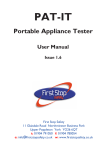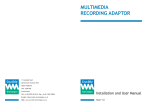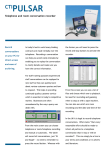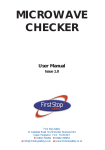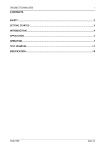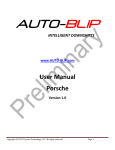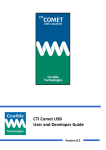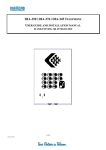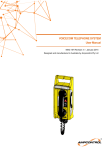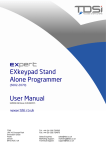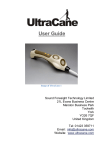Download Manual - Crucible Technologies
Transcript
Crucible Technologies 1 CONTENTS SAFETY ................................................................ ................................................................................................ ............................................................................ ............................................2 ............ 2 GETTING STARTED ................................................................ ........................................................................................... ...........................................................3 ........................... 3 INTRODUCTION................................ INTRODUCTION ................................................................ ................................................................................................ ................................................................4 ................................ 4 APPLICATION ................................................................ ................................................................................................ ................................................................... ...................................5 ... 5 OPERATION ................................................................ ................................................................................................ ...................................................................... ......................................6 ...... 6 TEST EXAMPLES ................................................................ .............................................................................................. ..............................................................11 .............................. 11 SPECIFICATION ................................................................ ............................................................................................... ...............................................................16 ............................... 16 Labline Issue 3.1 Crucible Technologies 2 SAFETY Read this manual completely before using the instrument. 1. The LABLINE is designed to behave like an exchange line therefore only telecommunication apparatus designed to connect to telephone lines must be connected to it. 2. Under no circumstances must the LABLINE be connected to the Public Switched Telephone Network (PSTN) or any PABX extension ports. 3. When using the LABLINE to test the performance of unapproved telecommunication apparatus, due consideration must be paid to any hazard involved. 4. WARNING The connection sockets have high voltages present during Ringing and Pulse dialling. Although this is not hazardous, it can be painful. 5. The unit is designed to be powered from a 230 V, 50 Hz source. The IEC Power Lead provided is fitted with a 5 Amp fused mains plug. 6. The Mains Switch at the IEC Socket needs to be in the Off position to isolate the unit from the mains. 7. There are no user serviceable parts in this unit. Under no circumstances should the user attempt to open the unit. If opened, the warranty will be invalidated. 8. Should the unit require a service, repair or calibration, please return it to a recognised dealer or to: Cricuble Technologies 11 Glaisdale Road Northminster Business Park Upper Poppleton York YO26 6QT Labline Issue 3.1 Crucible Technologies 3 Tel: +44 (0) 8702 60 60 82 When returning the unit to Crucible-Technologies, please contact the Repairs Department to receive a Returns Number. The owner will be advised of any costs prior to work commencing. GETTING STARTED Before using the LABLINE, please check that the following items have been included in the shipment. • LABLINE Unit • IEC Power Lead • Handset • User Manual Check for damage in transit. If there is any sign of damage, please report it to your supplier and do not attempt to repair the unit. The unit is factory set to be powered from a 230 V supply. This is indicated on the rating plate. (If a 110 V unit has been supplied, the rating plate will indicate this). Please ensure that this product is powered from the correct source. The apparatus is CLASS II double insulated construction, so does not require a protective earth connection. UNDER NO CIRCUMSTANCES CIRCUMSTANCES SHOULD THIS PRODUCT BE CONNECTED TO THE PSTN. Labline Issue 3.1 Crucible Technologies 4 INTRODUCTION The LABLINE is a bench top telephone line simulator designed to test a wide range of telecom products. It simulates a telephone line, enabling one to test most functions of a telephone on one instrument. The LABLINE provides a realistic simulation of telephone lines. The feed voltage applied to the Unit Under Test (UUT) is 48 V and the ring voltage is a real 70 V, 25 Hz signal with DC backing. This ensures that telecommunication apparatus that work on the LABLINE are sure to work on real telephone lines. It is useful for engineers who need to test products. However, the controls are straightforward to use which makes it ideal for non-technical personnel. Labline Issue 3.1 Crucible Technologies 5 APPLICATION There are a wide variety of applications for LABLINE, some of which are listed below: FAULT ANALYSIS The LABLINE is useful for checking returns from customers to make sure the fault lies with the returned product and not with the user. Non-technical staff are able to check a telephone or an answering machine, just by connecting it to the LABLINE and carrying out tests, as one would do if using a normal phone line. In less than a minute, tests such as off-hook, dialling, handset operation and ringing can be completed. The LABLINE provides many benefits over using a telephone line for testing. All the dialled digits can be checked and not just the digits needed to route a call. One person can carry out complete testing as ringing starts at the push of a button. No call costs are incurred. REPAIR The LABLINE provides a telephone line on every technician’s workbench. This allows products to be checked as repairs are carried out. On completion of the repair, the telephone or answering machine can be fully checked including operation with switchable polarity and line current. PRODUCTION The LABLINE can be used for production testing of many telecommunication products. Features such as digit timings, signal level (displayed on the bar graph) and adjustable ring level, will allow the test engineer to build the LABLINE into a production test procedure. Labline Issue 3.1 Crucible Technologies 6 OPERATION SUPPLY The unit is designed to be powered from the mains 230 V, 50 Hz. Versions of the unit powered from 110 V can be supplied. Please contact your supplier for this voltage option. PHONE SOCKET The phone socket is fed from a 48 V source. When the polarity switch is set to positive, A is positive wrt B. This is reversed when the polarity switch is set to negative. When the line current is set to Hi, this represents a 1 km line and when set to Lo it represents a 7.5 km line. The pin configuration on the socket is representative of a standard phone socket on the wall and is as follows: A B E S ⇒ ⇒ ⇒ ⇒ Pin Pin Pin Pin 2 5 3 4 Within the LABLINE, there is a 1.8 µF/250 V capacitor to feed the ringing to the UUT. This capacitor is connected between pins B and S. NOTE: 4mm sockets are also provided. They are connected to pins A and B. These are useful as measurement points or to connect any adapters. RINGING The ringing is applied to the UUT by operating the Ring On/Off switch. The ringing cadence is that of the standard UK PSTN. The pre-set control at the back of the LABLINE can set the level of the ringing. Once ringing is applied, it can either be stopped by operating the Ring On/Off Labline Issue 3.1 Crucible Technologies 7 switch or by seizing the line (i.e. answering the call) with the UUT. NOTE: If continuous ringing is required for test purposes, then turn power on whilst holding the Ring Switch down. After about 5 seconds release the switch. The LABLINE will generate ringing continuously DIAL TONE The Dial Tone provided on the LABLINE is a realistic 350 + 440 Hz as found on most modern exchanges. This is presented to the UUT when it seizes the line prior to dialling. However, if the line is seized in response to ringing no dial tone is applied. DIALLING The digits dialled by the UUT are shown on the 8 digit LCD. The digits can be Pulse, Tone or both. The Tone digits are shown with a dot underneath to differentiate them from the Pulse digits. The timing limit on the Make and Break of Pulse dialling are set carefully to detect any problem that may exist. The level of tones is displayed on the Bar Graph. A Time Break Recall (TBR) signal is either displayed as a Pulse digit 1 or R depending on its timing. If the break time is less than 80 mS then a Pulse digit 1 is displayed. If the break is greater than 80 mS then an R is displayed. This way the time limits for Pulse break are not compromised. An Earth Recall is shown as an E on the LCD display. When more than 8 digits are dialled and there is a pause of more than 5 seconds the display starts to scroll all the digits dialled. A maximum of 64 digits can be detected and displayed. When the UUT is On-line, the display scrolling can be frozen by pressing the Ring On/Off button. In the frozen mode the display flashes. The freeze can be terminated by the operation of the Ring On/Off button or by dialling a digit. Labline Issue 3.1 Crucible Technologies 8 NOTE: The display freeze only works in the On-line mode, as in the Off-line mode, the Ring On/Off button is used to turn the signal on. The scrolling of the display carries on in the Off-line mode. PULSE DIAL TIMINGS Pulse dial Make/Break/IDP timings can be brought up on the display by dialling 200 after seizing the line. The displayed Make/Break timings are based on the last digit dialled and the IDP based on the last two digits dialled. Further digits (Pulse or Tone) can be timed by dialling these after 200. The display will automatically update to show the Make/Break timings of the last digit dialled and the IDP between the last two digits. TONE DIAL TIMINGS Tone dialling On/Off times can be displayed by entering 200 after seizing the line. On timings are based on the last digit dialled whilst Off timings are based on the pause between last two digits dialled. Further digits (Pulse or Tone) can be timed by entering these after dialling 200. PULSE DIAL TIMING CHECK CHECK During Pulse dialling, if the following timing errors are detected, an error message is flashed on the display: MAKE TIMINGS BREAK TIMINGS Limits 33.3 mS ± 30% Low timing gives an error High timing gives an error Limits 66.6 mS ± 30% Low timing gives an error High timing gives an error MKE<23 mS MKE>43 mS MKE<46 mS MKE>86 mS Transients of less than 5 mS duration are ignored. The error message will time out after five seconds. However, if a valid digit is detected or another error message is to be displayed, the original message will be Labline Issue 3.1 Crucible Technologies 9 overwritten. Labline Issue 3.1 Crucible Technologies 10 DIAL UP SUPERVISORY TONES Various supervisory tones can be dialled up by keying in specific codes from the unit plugged into the master socket. These are given below: 300 ⇒ RING BACK TONE 301 ⇒ PAY TONE 302 ⇒ ENGAGED TONE 303 ⇒ PATH ENGAGED (PARK) TONE 304 ⇒ UNOBTAINABLE TONE NOTE 1: The frequency for all the above tones is set to 400 Hz. NOTE 2: In addition to the above, a couple of self-test features are provided. 100 ⇒ GIVES ISSUE OF SOFTWARE 999 ⇒ TESTS LCD HANDSET The LABLINE is supplied with a handset fitted with a push-to-talk button. The handset socket is located on the rear of the LABLINE. When testing answering machines, the handset can be used to listen to messages from and record messages to the answering machine. Labline Issue 3.1 Crucible Technologies 11 TEST EXAMPLES FUNCTIONAL TEST OF TELEPHONES TELEPHONES START PLUG UNIT IN AND LIFT HANDSET FAULTY HOOK SWITCH NO LINE LOOPED LED ON? YES HEAR DIAL TONE? NO HANDSET RECEIVER FAULTY NO HANDSET MICROPHONE FAULTY NO KEYPAD FAULTY NO RINGER FAULTY YES SPEAK INTO HANDSET, SPEECH ON BAR GRAPH? YES DIAL 1, 2, 3…9, 0 SEE DIGITS ON DISPLAY? YES REPLACE HANDSET CHECK IF RINGER IS ON OPERATE RING ON/OFF SWITCH TELEPHONE RINGING? YES PASS Labline Issue 3.1 Crucible Technologies 12 RING DETECT SENSITIVITY SENSITIVITY ON AUTOAUTO-ANSWER APPARATUS START SET UNIT NOT TO ANSWER. PLUG INTO LABLINE HOLD RING SWITCH DOWN AND POWER ON TO GET CONTINUOUS RINGING CONNECT DVM TO 4 mm TERMINALS ADJUST RING LEVEL CONTROL TO GET REQUIRED LEVEL (eg 20 V rms) SWITCH LABLINE OFF AND ON AGAIN OPERATE RING SWITCH TO START RINGING PASS Labline YES UNIT AUTO-ANSWERS? NO FAIL Issue 3.1 Crucible Technologies 13 ANSWERING MACHINE CLEARDOWN CLEARDOWN TO SILENCE START PLUG UNIT IN TO LABLINE OPERATE RING SWITCH WAIT FOR UNIT TO ANSWER LISTEN TO OUTGOING MESSAGE PRESS TO TALK AND USE HANDSET TO LEAVE A MESSAGE RELEASE BUTTON PASS Labline YES ANSWERING MACHINE DROPS LINE IN 6 SECONDS? NO FAIL Issue 3.1 Crucible Technologies 14 ANSWERING MACHINE CLEARDOWN CLEARDOWN TO LINE BREAKS BREAKS START PLUG UNIT INTO LABLINE OPERATE RING SWITCH WAIT FOR UNIT TO AUTO-ANSWER LISTEN TO OUTGOING MESSAGE DURING THE PLAYING OF THE OUTGOING MESSAGE, OPERATE LINE BREAK SWITCH MOMENTARILY PASS Labline YES ANSWERING MACHINE DROPS THE LINE IMMEDIATELY? NO FAIL Issue 3.1 Crucible Technologies 15 ANSWERING MACHINE CLEARDOWN CLEARDOWN TO EXTENSION PHONE PHONE PICK UP START PLUG UNIT INTO LABLINE AND USING A DOUBLER, PLUG IN A NORMAL TELEPHONE IN PARALLEL OPERATE RING SWITCH WAIT FOR UNIT TO AUTO-ANSWER DURING THE PLAYING OF THE OUTGOING MESSAGE, PICK UP THE TELEPHONE PASS Labline YES ANSWERING MACHINE DROPS THE LINE IMMEDIATELY? NO FAIL Issue 3.1 Crucible Technologies 16 SPECIFICATION MASTER SOCKET DC Voltage Feed Bridge DC Resistance DIAL TONE Frequency Level 48 V ± 5% 2 x 200 Ω ± 10% 180 Ω ± 10% (= 1 km line) 1380 Ω ± 10% (= 7.5 km line) 350 Hz + 440 Hz -8 / -14 dBm Cadence 70 V ± 10% rms (factory default) Adjustable from 0 V to 95 V rms 25 Hz AC (near sinusoid), DC backed PSTN PULSE DIALLING Make Break IDP On-Hook Off-Hook TBR 25-41 mS 50-82 mS >200 mS >300 mS >200 mS 80-110 mS TONE DIALLING Tone Time Accept Frequency Reject Frequency >40 mS ± 1.5% ± 3.5% RINGING Voltage User Level Frequency Type BAR GRAPH Range Top LED set to –1 dBm ± 1 dB 3 ± 1 dB per LED TOLERANCE unless otherwise specified Frequency Timing Level ± 10% ± 10% ± 3 dB POWER Mains 230 V, 50 Hz, 50 mA Labline Reference Issue 3.1


















